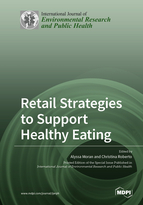Retail Strategies to Support Healthy Eating
A special issue of International Journal of Environmental Research and Public Health (ISSN 1660-4601).
Deadline for manuscript submissions: closed (5 September 2020) | Viewed by 79848
Special Issue Editors
Interests: chronic disease prevention; food and nutrition policy; food security
Special Issue Information
Dear colleagues,
In January 2020, the Center for Science in the Public Interest (CSPI), The Food Trust, Johns Hopkins Bloomberg School of Public Health, and Healthy Eating Research (HER) met for a Healthy Retail Research Convention in Washington D.C. Attendees included food industry representatives, researchers, and nonprofit organizations. The objective of the convention was to develop a national healthy retail research agenda by: 1) determining the effectiveness of government policies, corporate practices, and in-store pilots in promoting healthy eating; 2) identifying gaps in the healthy food retail literature and generating questions for future research, with an intentional focus on reducing health disparities and improving equity; 3) highlighting best practices for partnering with retailers and food manufacturers on healthy retail research; 4) facilitating relationships between retailers and researchers to implement and evaluate retail interventions; and 5) identifying existing datasets, ongoing work, and new opportunities for retail–research partnerships.
This Special Issue will include a summary of the research convention final report, which will describe the scope of the healthy retail research agenda, the agenda-setting process, and recommendations from expert stakeholders on healthy retail research approaches, data sources, and key areas of future research. The issue will also include several review papers and one original research article, commissioned specifically for the convention, detailing the current state of the retail food environment. These papers will summarize current knowledge on consumer food purchasing trends, the influence of food and beverage companies on the retail food environment, stocking and marketing of sugar-sweetened beverages, in-store food and beverage marketing interventions, and governmental policies to improve the healthfulness of food purchases. Additionally, the issue will include two conceptual frameworks describing the influence of the U.S. retail food environment on food choice—one paper will focus on brick-and-mortar stores, and one will focus on online grocery. Lastly, we will include two commentaries. One will discuss the effects of COVID-19 on the food system and suggest priority areas for future investigation. The other will come from the food retail sector and describe outcomes of interest to industry, challenges to engaging in public health partnerships to support healthy eating, and facilitators of effective retail–research partnerships.
Dr. Alyssa Moran
Dr. Christina Roberto
Guest Editors
Manuscript Submission Information
Manuscripts should be submitted online at www.mdpi.com by registering and logging in to this website. Once you are registered, click here to go to the submission form. Manuscripts can be submitted until the deadline. All submissions that pass pre-check are peer-reviewed. Accepted papers will be published continuously in the journal (as soon as accepted) and will be listed together on the special issue website. Research articles, review articles as well as short communications are invited. For planned papers, a title and short abstract (about 100 words) can be sent to the Editorial Office for announcement on this website.
Submitted manuscripts should not have been published previously, nor be under consideration for publication elsewhere (except conference proceedings papers). All manuscripts are thoroughly refereed through a single-blind peer-review process. A guide for authors and other relevant information for submission of manuscripts is available on the Instructions for Authors page. International Journal of Environmental Research and Public Health is an international peer-reviewed open access monthly journal published by MDPI.
Please visit the Instructions for Authors page before submitting a manuscript. The Article Processing Charge (APC) for publication in this open access journal is 2500 CHF (Swiss Francs). Submitted papers should be well formatted and use good English. Authors may use MDPI's English editing service prior to publication or during author revisions.
Keywords
- Healthy food retail
- Retail food environment
- Consumer food purchasing
- Marketing






